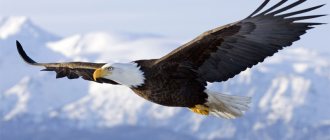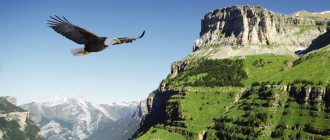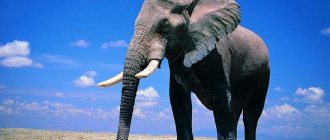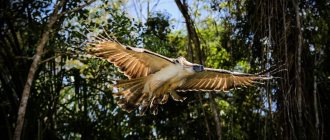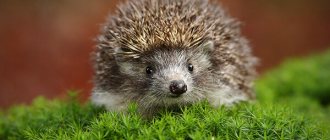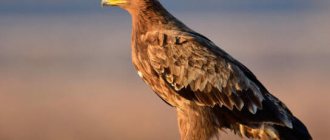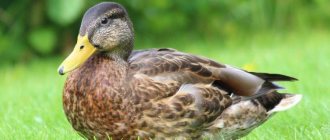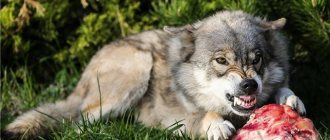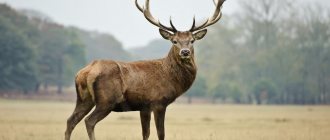The steppe expanses and semi-deserts of Central Russia, Siberia, the Far East and Asia are home to one of the species of large birds of the hawk family (Accipitridae), named after its distribution area - the steppe eagle (Aquila nipalensis).
Features of the environment have left their mark on the appearance, habits and habits of the bird of prey, which belongs to the rare species of raptors listed in the Red Book. Their numbers are gradually decreasing - now there are 26-36.7 thousand pairs in the world, 2.1-3.1 thousand pairs nest in the Russian steppes. Interesting and unusual facts about structure, vision, hunting, and reproduction will help complement the image of the steppe inhabitant.
Eagle flight performance
From the ground, it may seem that a large bird is barely hovering above the ground, its wings spread wide. However, the eagle’s “flight” performance is very impressive. While “soaring,” the eagle can fly at a speed of 190 to 240 kilometers per hour (even when driving on a highway, you can’t catch up with it!). The illusion of slow movement is due to the enormous flight altitude - over 700 meters. And it dives at an exorbitant 320 kilometers per hour, which is absolutely amazing.
The design of eagle wings with splayed “fingers” at the tips provides stronger air currents from below than from above the wing, and determines the bird’s high lifting force. This is how the predator gained the ability to soar without moving its wings. And work with them only by taking off and accelerating when pursuing prey.
In addition, its flight is very stable. The eagle is able to fold its wings slightly, leaving the tips spread, and maintain smooth flight during a hurricane.
Whychek club and experiments for children
In addition, here is an archive of issues of the “ Why Chek Club”
“, which I blogged weekly until 2022.
In this section I answered questions from little whys. And she not only answered, but conducted a comprehensive developmental lesson on this topic. We made crafts, conducted experiments, played games - and along the way we learned the answer to the question asked.
Why is the head round? Why is milk white? Why can you hear the sea in a shell? There are so many interesting things in the world, and learning physics, biology, chemistry, history and other sciences is so much fun!
I collected the first 14 issues of the Club into the e-book “The Why-Check Club. Science in Questions and Answers”, which can be downloaded for free by filling out the subscription form:
After you fill out the form,
You
will receive an email from the mailing service
asking you to confirm that you are the owner of this e-mail address.
After you click on the “ Confirm
” link, in a few minutes a letter will be sent to your email containing a link to download the e-book “Why Club. Science in Questions and Answers” in pdf format.
Archive of “Why Chek Club” releases
(educational thematic activities - popular science for children)
Pilot episode. Why don't people fall out of swings? – to children about gravity
Reception of questions to the Club is closed!
Eagle vision
Look The eagle
has very sharp, wide-ranging vision. Each eye of an eagle is capable of focusing on 2 objects at once (in humans, on one), visual acuity allows you to see a hare at a distance of over three kilometers, and with a peripheral glance it can cover 270 degrees. From a flight altitude, an eagle is able to see prey on a surface area of 11.5 kilometers.
Interesting: Interesting facts about the human body, photos and videos
All this is intended to make the bird an excellent hunter, able to see prey at great distances and able to accurately calculate the distance to attack it.
Interesting fact : eagle eyes are closed by two eyelids: transparent and dense. The first, completely transparent, are adapted to withstand prey or strong winds. And the latter allow you to sleep.
Enemy of Man
It is known that some species of eagles are capable of hunting large animals. For example, in the Philippines there are large eagles called harpy or monkey-eaters. They are capable of carrying not only a monkey, but also a goat or antelope in their beak.
Some species of eagles dare to attack people. So, in 2012, in Montreal, Canada, an eagle almost dragged a child from a city park. In 2016, a similar incident occurred in Australia, where a bird tried to drag away a child who was playing with a zipper on a hoodie. Experts suggested that it was the sound of the zipper opening and closing that attracted the bird of prey.
In September 2022, a child was attacked by an eagle in Ethiopia. The bird, of which it was not possible to take a photo, grabbed the child with its claws and did not let go, despite the mother’s cries. The police were ordered to kill the eagle, but it fled the scene. The boy died from his wounds.
In fairness, it should be noted that human activity has led to the fact that most species of eagles on Earth have been brought to the brink of extinction. According to statistics, more than 60% of bird deaths occur due to human fault (shots, collisions with wires or buildings, etc.). But this worries people less than isolated cases of bird attacks.
Hunting
Eagle Hunting
Eagles are effective at hunting. They do not kill unnecessary animals; they catch only for their own food and for their chicks. They mainly hunt small game.
Eagles not only obtain food on their own, but are also ready to engage in outright robbery. For example, they can take prey from a smaller bird of prey on the fly.
Eagles are excellent at hunting flying birds. They overtake the prey by surprise, because they hunt from such a height that the bird cannot see them. And then they dive at such a speed that the prey does not have time to notice them. The slow-motion footage of the eagle fighting with its prey in flight is interesting. An eagle can catch birds on the fly and carry the trophy further.
These birds are distinguished by their special temperament and unbending will. The eagle is a bird that in many cultures has become a symbol of courage, pride, bravery and other positive qualities.
2. The Romans believed that the eagle was the squire of Jupiter’s smog; it was supposed to store and carry formidable lightning.
3. The eagle has a powerful body and long, wide wings. The eagle’s beak is massive, its paws end in claws curved inward, and “pants” are formed on the hips with feathers.
4. In nature, eagles are one of the most formidable representatives of birds, and the only creature that poses a real threat to them is a person who displaces eagles from their usual habitats. Despite this, there are still many places on Earth where eagles are found in abundance.
5. Males often help eagles hatch eggs.
6.The wingspan of an eagle reaches 2.4 meters with a body length of up to 88 centimeters.
7.Female eagles are much larger than males.
8. The flight altitude of eagles is up to 7-9 kilometers. Not every plane can reach such a height.
9.Eagles can mate in flight.
10. In many countries, the eagle symbolized absolute power. This gave confidence, the person felt like the chosen one of the gods. The Aztecs made jewelry from eagle feathers. The military elite wore cloaks embroidered with jewels and eagle feathers, which resembled the wide wings of a bird of prey. Sandals tamed by the claws of eagles.
11. Eagle nests are the largest nests that birds build. Eagles build their nests at the maximum height available in a given area. They do this to ensure safety for the chicks, to have an excellent vantage point and ambush site at the same time, and to take off with less effort. Every year they expand and complete their nests.
12. A predator’s gaze is capable of focusing on two objects at the same time (a person can focus on only one).
13. Eagles have fantastic vision, it is six times better than that of humans. Eagles fly out to hunt during the daytime. The bird is not disturbed by the sun's rays or glare of water; they can easily see the smallest objects and small animals in the grass from a bird's eye view.
14. Looking at the eagle, it seems that it is slowly soaring on huge wings. In fact, the bird flies with amazing speed, a misleading impression arises because the bird flies at a great altitude (not lower than 700 meters).
15. Eagles are capable of taking prey from a smaller bird even in flight or attacking it itself.
16.If two chicks appear in an eagles nest, the stronger one will try to get rid of the other for 2 months. If the weak chick manages to survive, then they begin to live quietly in the nest with each other.
17. With the help of strong claws, the eagle tenaciously grabs the victim not only on the ground, but also in the air.
18. Usually a couple has two eaglets in a year. The family life of eagles resembles the everyday relationships of people. The male must get food, the female raises and feeds the babies, and protects the nest.
19. Perfect aerodynamics are vital for eagles, so if a bird loses a feather from one wing, the same feather will fall out of the other.
20. In antiquity, eagles were considered a symbol of victory and good luck, and in Egypt and China - a symbol of the sun.
21. Eaglets begin to hunt independently when they are 3 months old. These birds reach full maturity by 4-5 years.
22. An eagle can lift into the air a prey weighing equal to its own.
23.Eagles are excellent at hunting flying birds. They overtake the prey by surprise, as they hunt from such a height that the bird cannot see them. And then they dive at such a speed that the prey does not have time to notice them.
24. Sometimes, if the eaglet does not dare to leave the nest, the parent sits in front of the nest with prey and begins to call the timid eaglet.
25. Eagle eyes are closed by two eyelids: transparent and dense. The first, completely transparent, are adapted to withstand prey or strong winds. And the latter allow you to sleep.
26. During flight, an eagle soars above the ground at a speed of 200 km/h. At the sight of a potential victim, the bird can accelerate to 320 km/h.
27. From a flight altitude, an eagle is able to see prey on a surface area of 11.5 kilometers, and with a peripheral glance it can cover 270 degrees.
28. Eagles are effective in hunting, but they do not kill unnecessary animals; they only catch for their own food and for their chicks.
29. The skeleton of an eagle weighs half as much as its feathers.
30. The eagle is present on the coats of arms of many countries of the world, including Russia.
31. Eagles are very faithful birds; they mate for life. Some ornithologists discovered a pair of eagles that had lived together for more than thirty-five years.
32. Eagles mainly hunt small game, but they are capable of lifting a small fawn into the air.
33. After 40 years, the beak and talons of eagles of large species grow to such an extent that the birds practically lose the ability to eat and hunt. There are two options for the further development of events: the eagle either dies or breaks its beak on stones, pulls out its claws and old feathers, and six months later it is reborn like a phoenix to live on and lives for many more years. One can only envy such strength of character.
34. A proud bird flying so high was taken in Hinduism, Christianity and other religions as the embodiment of the divine face.
35. The special design of eagle wings helps them fly calmly even in a hurricane.
photo from the Internet
Nest
Eagle nests are built at the maximum height of a given area. They do this to ensure safety for the chicks, to have an excellent vantage point and ambush site at the same time, and to take off with less effort.
The nest is established for many years, being completed and expanded every year. Since it is located very high, as soon as the chicks appear in it, the eagles decorate it with a “canopy” of branches, most often pine. Green branches provide enough shade to protect from the scorching sun.
Habitat
There are several places where the eagle lives. Basically these are places where people live. Therefore, among the habitats are the North Caucasus, southern Primorye, Transbaikalia, and the Black Sea coast.
Representatives of the family are also found in different parts of the world:
- Iran.
- China.
- Ukraine.
- Hungary.
- Greece.
- Slovakia.
- Kazakhstan.
- Germany.
- Romania.
- Czech Republic.
- Spain.
- New Guinea.
Eagle families
Eagle Families
Eagles are very faithful birds; they mate for life. Some ornithologists discovered a pair of eagles that had lived together for more than thirty-five years.
Interesting: Interesting facts about octopuses, photos and videos
These birds have a wonderful organization of life. When the chicks are still very young, the parents share family functions. The male becomes the breadwinner, and the mother becomes the educator and nurse. She protects the nest and feeds the chicks, dividing the prey for them. Chicks usually hatch 1-2 per year. After 3 months they grow up and begin to fly to hunt on their own.
Sometimes, if the eaglet does not dare to leave the nest, the parent sits in front of the nest with the prey and begins to call the timid child.
Diet
Prey for the eagle are medium and small animals, such as foxes, hares, mice, marmots, martens, hedgehogs, rabbits, stoats, gophers and squirrels. Large eagle individuals also attack young roe deer, deer, antelope, young foxes and wolves, as well as sheep and cows. Eagles often hunt birds such as pigeons, wood grouse, partridges, geese, and owls. If the eagle's habitat is Australia, North and South America, then they feed on squirrels, parrots, bats, owls, and sometimes monkeys.
When learning what eagles eat, it is worth saying that the diet of some species of this bird includes fish. They also do not neglect reptiles, such as lizards and turtles.
Chicks
Eagle chicks
When talking about chicks that are born in families of raptors, it is worth noting the following:
- The eggs are incubated primarily by the female eagle, but the male actively helps her in this, replacing her if necessary;
- Incubation of eggs lasts 40-45 days depending on the type of eagles;
- Also, depending on the type, the clutch may consist of 1-3 eggs;
- If the chick appears more than one, for the first 2 months there is a competitive struggle - the stronger one tries to get rid of its brother or sister. If this cannot be done within 2 months, peace reigns in the nest, the chicks no longer conflict;
- At 3 months, the parents' care for it stops, the chick is able to hunt on its own;
- Maturity comes to the mighty bird only at 4–5 years.
List of the most common types
- The golden eagle is the largest eagle in the world and typically weighs around 7 kg. The body length of such an individual reaches 76-93 cm, and the wingspan is 1.8-2.34 meters. These types of eagles have a distinctive feature: the rear edge of the bird’s wings when soaring has the shape of the Latin letter “S”, and it is curved. Young golden eagles have black plumage with white “signal” spots on the wings. This becomes a typical defense against the aggressive behavior of the older generation.
- The hawk eagle is distinguished by a black-brown color on its back and a white belly with transverse stripes of a dark shade. The weight of this type of eagle is approximately 2.5 kg, and its wing length is 46-55 cm. Moreover, the body length of such an eagle reaches from 65 to 75 cm.
- The stone eagle is a steppe and savanna species, usually living in southwestern Africa and Iran, as well as in northwestern India. The body length of such a bird is 60-72 cm. With a wingspan of 159-183 cm, the weight of a male can be 2 kg, and the weight of a female can be from 1.6 to 2.5 kg.
- The Imperial Eagle is a rare representative of the eagle family, which is similar to the golden eagle. The only difference is the characteristic white markings - epaulets on the shoulders. This type is considered one of the most vocal species of eagle. His cry can be heard even at a distance of up to 1 km. The body length of such an eagle is 72-84 cm, the wingspan is 180-215 cm, and the weight is 2.4-4.5 kg.
- Based on its name, the dwarf eagle is a medium-sized species with a weight of up to 1.3 kg and a length of no more than 53 cm. The body size of such an eagle can resemble buzzards. The wingspan of such birds reaches 100-132 cm. Such predators differ from typical representatives of the genus by their elongated tail and narrowed wings.
Interesting facts about the eagle
Females of all eagle species are larger than males, and the difference in size can be quite significant. But the enormous power of the wings and the height of flight are relevant for both sexes - each eagle can overcome a height of 7, even 9 km . And these birds even tend to build nests at the highest point in the area where they live. It is not surprising that a strong, proud and inaccessible bird, conquering heights no worse than an airplane, became a symbol of the ancient gods and appeared on many coats of arms, including the Russian one. It is also worth noting the following facts:
- It’s not just the eagle’s visual system or the structure of its wings that is unique. Even the bird’s skeleton is adapted for flying at altitude - it weighs half as much as its feathers;
- The strength of the celestial predator is such that it is able to grab and lift into the sky a not too large fawn;
- The Eagle requires good aerodynamics. If a feather falls out of one of its wings, it is also lost from the second - even if the first was torn out on purpose or was lost due to injury or blow.
Interesting: Interesting facts about Ancient Mesopotamia (Mesopotamia)
Experiments for children with step-by-step instructions:
Chemical and physical experiments for children:
- Chemical experiments for children - a large selection of simple experiments for children
- Color experiments in chemistry (we obtain multi-colored liquids as a result of chemical reactions)
- “Magic Potion” – experiments on mixing liquids of different colors and densities
- How to make colored fire? (chemical experiments with flame coloring)
- Experiments with fire for children (chemical wick, fireworks and pharaoh's snake)
- Experiments with fire - we light paper with a magnifying glass and a fireproof bill.
- Coin trick (for refraction of rays)
- How to make a rainbow? (for children about the rainbow and a simple experiment)
- Trick with a picture upside down (learning the laws of optics)
- 13 experiments with balloons - simple and effective experiments and tricks that use balloons
- Otherworldly sounds from a balloon (we cause interesting sound effects)
- Ball with a tail (what is the stabilizer used for?)
- Super whistle from a balloon (let's find out why the whistle whistles)
- Electrostatic octopus (Phenomenon of static electricity)
- Magic butterfly. Physical balance toy
- Paper ballerina. Physical balance toy
- Potato balance bird. Physical balance toy
- Scientific pranks and joke problems for April 1 - a selection of funny scientific deceptions for April Fool's Day
- Experiments with a chicken egg - what happens to an egg immersed in salt water or vinegar
- Trick with a glass - demonstration of water pressure
- “Vanka-rising from an egg” – experiments on balance
- Tricks with paper tapes - study of topological properties. Introduction to the Möbius strip
- Experiments with magnets - we study the properties of magnets. On the sidebar of the blog you can download an e-book in PDF format based on these experiments “Games and experiments with magnets”
- Microphone from a tin can - sound vibrations.
- Manifesting Valentine - chemical experiment
- Steam turbine - a model demonstrating the work of steam
Experiments and experiences in natural science
- Learning about wind - 5 lessons for children on Wind Day
- What happens to the packages? – ecology experiment
- The water cycle in nature - a model in a jar
- Is it possible to drink sea water? Water desalination experiment.
- Home weather station: homemade barometer (getting acquainted with atmospheric pressure)
- Home weather station: do-it-yourself rain gauge (we make meteorological instruments at home)
- Home weather station: hygrometer from a pine cone (we measure air humidity using a homemade device)
- Home weather station: measuring wind force (we design the device)
- Soil structure - educational activity in natural science
- The influence of soil on plant growth - educational activity in natural sciences
- How to make a weather vane - educational activity in natural science on the topic “Wind”
- 7 ways to determine the cardinal directions - educational activity in natural science
- Cloud Hunt – educational activity in natural science on the topic “Clouds”
- Making a sundial - an educational activity in natural science
- Profession – sailor (thematic week – 7 lessons)
- History Games – Writing Tools – educational activity on the history of writing
- History games – Ancient Greece – educational history lesson
- How to make a cartoon yourself - experiences and experiments with optical illusions. Their applications in animation.
- Water clock - clepsydra - educational history lesson: repeating the invention of the water clock
- Mining and smelting of metals - a developing lesson in natural science
Experiments and experiences in biology
- All about pumpkin for children: themed research week
- 7 lessons about snails – we study gastropod mollusks with children, conduct experiments and experiments!
- Get to know your heart - 6 anatomy experiments and experiments for children
- Does a hamster have intelligence? Biology research project 2nd grade (experiments with a Syrian hamster in mazes)
- What do we know about the egg: educational activity with a book (we study bird eggs using the encyclopedia “The Egg Loves Silence”))
- Let's experiment on ourselves! (experiments in physiology and biology for kids)
- Experiments with plants: Where is up, where is down? (3 experiments on plant geotropism)
- Experiments with plants: how do plants drink? (the concept of osmosis)
- Experiments with plants: 5 seconds of a miracle (we shoot a video about the germination of a sprout)
- Experiments with plants: the sun is life! (biology experiment on the role of the sun in plant life)
- Experiments with plants: underground storerooms (biology experiments with tubers, roots and bulbs)
- We study the earthworm. Part 1. Experiments on the street
- We study the earthworm. Part 2. Experiments at home.
- Pond on the windowsill - studying the life of a reservoir
- Playing detective - taking fingerprints - studying fingerprints
- On which bread does mold grow faster - an experiment on growing mold
- Let's play paleontologists and look for a mammoth
- The world through a microscope and Observing through a microscope - educational activities in natural science
- Snails – educational activity in natural science: studying the life of aquarium snails
Experiences and experiments in winter and New Year:
- New Year's experiences and experiments: Cracker (the nature of sound)
- New Year's experiences and experiments: Grape of wishes (buoyancy)
- New Year's experiences and experiments: squirrel for the Christmas tree (do-it-yourself balance toy, experiment on balance and center of gravity)
- New Year's experiences and experiments: Christmas tree in snow crystals (growing salt crystals)
- Making artificial snow (experiments with starch)
- Two experiments with snow (which snow melts faster and why the volume of snow is greater than the volume of water that comes from it)
- Is it possible to eat snow? (we compare the purity of the snow and find out where the dirt in the snow comes from. Based on the lesson “The world around us” in 1st grade)
- Growing a snowflake - experiments on obtaining table salt crystals
- Experiments and games with ice for children. Part 1.
- Experiments and games with ice for children. Part 2.
- On the sidebar of the blog you can download an e-book in PDF format based on these experiments “Experiments and games with ice”
Halloween experiences and experiments:
Space experiments and astronomical experiments:
- Tops-quasars: a dynamic toy with a space theme
- Space in a glass: an experience for children on Cosmonautics Day (we make planets and reproduce the process of formation of the Solar system).
- Experiments in astronomy with Chavostik (experiments based on a book about astronomy)
- How to see the ISS - educational lesson in astronomy
- Moon – educational activity in natural science
- Water-powered rocket - a model demonstrating the principle of jet propulsion
And here you can download two e-books with a selection of experiments for children on topics: E-book “Experiments and games with ice” (20 experiments and educational games).
Steppe eagle in the Red Book
The steppe eagle is classified in the third category in the International Red Book as a rare species. The bird is listed in the Red Book of Russia and Kazakhstan as an endangered species due to the reduction of necessary habitats.
Main causes of extinction
The factors causing the disappearance of predators include the threat to the habitat of birds in open areas where families of steppe eagles live. They are accessible to poachers and wild animals and birds - enemies of birds.
The reason for the population decline was the replacement of wooden transmission line supports with concrete structures. While looking for places to build nests, the birds died from electric shock.
The plowing of virgin lands leads to the disappearance of many wild animals and rodents, and therefore eagles do not receive enough meat food. This is one of the most important causes of extinction.
Current population situation
The population of steppe eagles is constantly decreasing. In Russia their number is no more than 20 thousand pairs. There are about 25 thousand pairs across the European continent.
The highest population density remains in Kazakhstan, Kalmykia, and Mongolia. The total number is currently unknown.
What measures are taken to protect
The bird species is listed in Appendix 2 of CITES, the Appendices of the Bonn and Berne Conventions. An agreement has been concluded between the Russian Federation and India on the protection of migratory birds.
The feathered predators are kept in zoos, where attempts are made to breed the species in captivity. There have been cases of targeted breeding of birds in nature reserves. However, breeding is not currently practiced.
